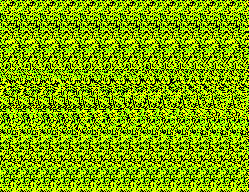 This next image contains a number of flat surfaces at various different
depths.
This next image contains a number of flat surfaces at various different
depths.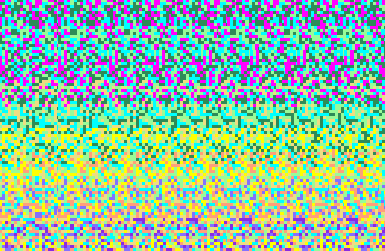 Until a very few years ago the only way to provide someone with a
realistic 3-dimensional percept involved making them look at a specially
prepared image through red/green specs. But this technique has now been
superseded (to some degree) by the SIRDS or `Magic Eye' method. This
enables a 3-dimensional percept to be presented without use of any
special equipment. It is currently being used in the generation of a
wide variety of images in many different media. Viewed raw, SIRDS or
`integrams' as I call them, appear to contain nothing more than
detailed, periodic patterns. But viewed with an offset vergence, they
provide a rock solid, specs-free 3-d illusion.
Until a very few years ago the only way to provide someone with a
realistic 3-dimensional percept involved making them look at a specially
prepared image through red/green specs. But this technique has now been
superseded (to some degree) by the SIRDS or `Magic Eye' method. This
enables a 3-dimensional percept to be presented without use of any
special equipment. It is currently being used in the generation of a
wide variety of images in many different media. Viewed raw, SIRDS or
`integrams' as I call them, appear to contain nothing more than
detailed, periodic patterns. But viewed with an offset vergence, they
provide a rock solid, specs-free 3-d illusion.In this file I will present some sample integrams and talk about how they can be constructed. I will also show a short `stereo flick'---a 3-dimensional movie made using the itegram method.
A encyclopaedic reference on stereograms is here.
Here is a simple integram which features the letters `WO' floating above a plain, flat surface.
 This next image contains a number of flat surfaces at various different
depths.
This next image contains a number of flat surfaces at various different
depths.
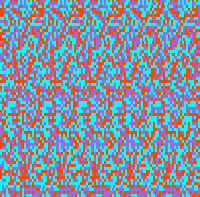 This one contains a snaking, downwards sloping staircase.
This one contains a snaking, downwards sloping staircase.
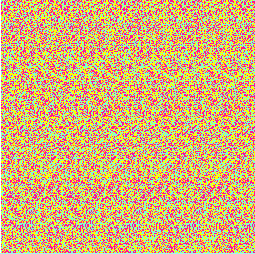 Here's a black-and-white integram (useful for printing out).
Here's a black-and-white integram (useful for printing out).
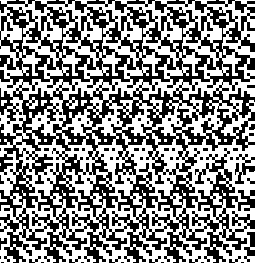 You may find these example easier to see when they are blown up to the
full size of the screen. You can do this by clicking on them to open up
them up in the XV viewer and then clicking the top-left-corner button on
the XV window to make it fill the screen.
You may find these example easier to see when they are blown up to the
full size of the screen. You can do this by clicking on them to open up
them up in the XV viewer and then clicking the top-left-corner button on
the XV window to make it fill the screen.
Click here  to run
the `stereo flick'---a short video showing one surface moving vertically
over another.
to run
the `stereo flick'---a short video showing one surface moving vertically
over another.
Animate visual systems use retinal arrays. These sense light falling on a roughly flat surface and thus deliver a 2-dimensional projection of the 3-dimensional world. Since organisms typically want to know something about the 3-dimensional properties of their world, they have to post-process retinal inputs so as to derive `depth' information, i.e., the real distances to the objects whose projections appear in the retinal array. If the organism has two eyes, this can be done quite effectively by
Settling on a a particular eye separation effectively `tunes' the visual system to stereo cues within a given depth of field (i.e., within given depth limits).
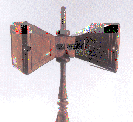
A better-known method involves the use of `red/green specs'. These are cardboard spectacles which cover one eye with a red filter and the other with a green filter. With these specs on, a viewer can obtain a 3-d image from a stereo pair drawn on a single surface, provided that one image in the pair is drawn in green and the other in red. The green image is effectively invisible to the green-covered eye and thus only gets to the red-covered eye, and vice versa.
The great advantage of the red/green specs method is that it enables the
stereo pair to be presented on a single 2-dimensional surface, such as
the page of a book or a cinema screen... 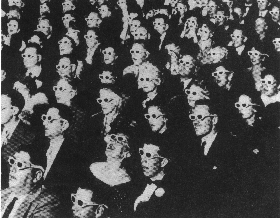
However, it also involves the viewer wearing the special spectacles. This is not ideal since what we would really like is to be able to produce 3-dimensional images on an ordinary 2-d surface without requiring the viewer to use any special equipment.
Intuition suggests that we shouldn't be able to do this. If we place our stereo pair on a single surface then the viewer's left eye will end-up seeing the dots in the right-eye's image and vice versa. But the insight underlying the integram method was that this wouldn't matter if those dots really were there in the right-eye's image. If the image can be somehow fixed up so so so as to ensure that whenever one eye sees the other eye's dot, that dot really is present in the first eye's image, the visual system will obtain a perfectly good stereo pair.
The idea sounds weird but it all boils down to a rather straightforward procedure for producing 3-d images. The basic idea is illustrated in the figure below. We imagine that we place the viewer's two eyes at one end of a rectangular frame. At the other end we place our chosen 3-dimensional surface and in between the two we place a blank, 2-dimensional image.
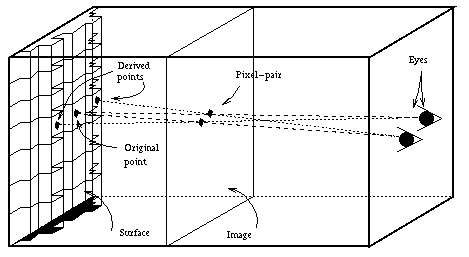 |
To construct an integram of the surface we first place a coloured dot---a blue dot, say---at some arbitrary point on the surface. We then draw straight lines back from the dot to the viewer's two eyes placing two blue dots where the lines pass through the image. We have now constructed a stereo pair for the single blue dot. Of course the right eye will see the left eye's dot and vice versa. So we must now place blue dots on the surface point the right eye will interpret as being `responsible' for the left eye's dot, and the surface point the left eye will interpret as being responsible for the right eye's dot.
To complete the image we simply continue this procedure until the image is filled up. Each time we come across a surface dot that hasn't yet been coloured in, we assign it a random colour and carry on. The final image created is a fully integrated stereo pair. If it is viewed with a suitable vergence (i.e., with eyes converging on a point on the imaged surface) a full, 3-dimensional percept is obtained.
A dirt-cheap method for generating integrams is to take a sheet of white paper, select an alphabetic character and then iterate it with a given frequency (i.e., every 10 spaces) across the page. Move down a line or two and repeat the process using a slightly different frequency. When you have a page full of iteracted characters, try viewing the page in such a way as to fuse two neighbouring characters in the top row. If your spacing didn't fluctuate too wildly, all the lines of characters should fuse up too, but at different depths.
One of the reasons fusing is hard may be that it involves making your visual system do something that it would never normally have to do, namely focus in one place while converging in another. Focussing on the image (while converging on the illusory surface) is essential if the image dots are to stay clear, unless the depth-of-field achieved by the visual system is sufficient to keep the dots clear even when the focal point is some way beyond the image. Thus difficulties in fusing may be to do with having poor depth-of-field or a lack of ability to `delink' focussing and convergence.
The almost insuperable problems people have in fusing integrams `back-to-front' suggests that depth-of-field may be the crucial factor. On the face of it, back-to-front fusing should be a perfect dual of the normal viewing process. The viewer converges on a point in front of the image rather than behind it (i.e., goes boss-eyed) thus inverting the geometry, making the surface appear to stick out in front rather than out the back. But back-to-front fusing is not a perfect dual of the usual procedure. It turns out to be very much harder! The theory that depth-of-field is crucial neatly accounts for this since the back-to-front fuser necesarily works at half the usual range, i.e., at a range where the depth-of-field is bound to be significantly diminished.
The amount of computation involved in the imaging process can be reduced still further by effectively sub-sampling the surface, i.e., by leaving a certain amount of white space between dots. If sub-sampling is used, however, it is very important to ensure that occlusion effects are taken care of. If the image is generated in a naive way, simply by iterating left-to-right colouring in every Nth dot, then it is possible to end up with right-eye dots for points on the surface which are actually occluded (and would therefore be over-written in a non-sub-sampling procedure).
Whatever method is used, it is important to remember that the resolution of the image must be substantially higher than that of the imaged surface. The increase in resolution is needed to to take account of the fact that surface patches at different depths effectively project sub-frames of different size into the image. The image resolution must be sufficiently high to enable these different sub-frames to be accurately represented.
| pop11 :lib integram |
For further information see the Poplog help file HELP INTEGRAM.
Comments, suggestions etc. to Chris.Thornton@cogs.susx.ac.uk.
Other stereogram-related pages on the WWW include
A couple of journal papers of relevance are Christopher W. Tyler, The Birth of Computer Stereograms for Unaided Vision, STEREOGRAM, Boxtree, 1994; and How to Play Tricks with Dots, in NEW SCIENTIST, 9 October, 1993.
 Page created on: Fri Apr 26 09:58:12 BST 2002
Page created on: Fri Apr 26 09:58:12 BST 2002